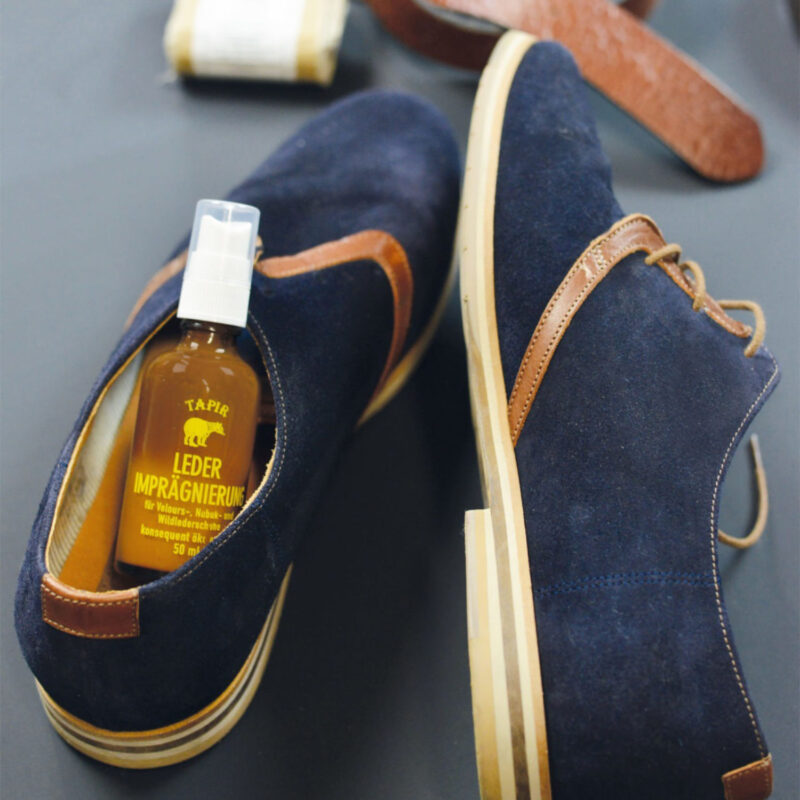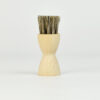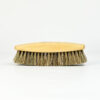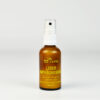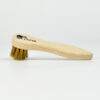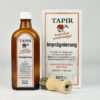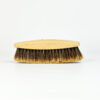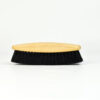Questions and answers
Protection for your treasures: Everything you need to know about Tapir impregnations
Tapirs leather impregnation for smooth leather consists of 100% natural raw materials and therefore offers environmentally friendly protection for shoes and bags made of smooth leather.
Natural ingredients such as lanolin, stearin, jojoba oil and orange oil effectively protect and care against moisture and moisture, while being gentle on the environment and gentle on the leather.
Impregnation is super easy to use: Simply clean the dirty shoes or bags first with a dirt brush or our Tapir Leather and Saddle Soap. Afterwards, the leather impregnation for smooth leather can be worked directly into the still damp leather, or it can be applied to the dry shoe.
Simply shake the bottle well before use and spray evenly on the object to be impregnated from approx. 20-30 cm. Note that the spray pattern is not always perfectly uniform and droplets can form. These droplets should immediately be evenly distributed on the leather with our Tapir Swelling Sponge or a Tapir Application Brush. Then let the leather dry briefly. Finally, use the gloss brush and massage the impregnation into the leather .
And the shoes are optimally protected, as an invisible barrier is formed on the surface of the smooth leather, which repels water, dirt and stains, but without compromising the natural breathability of the material.
Our impregnation for suede, nubuck and suede is made of 100% ecological and natural ingredients, namely pesticide-free lanolin, vegetable stearin, natural solvents, ammonia and water.
Before use, the shoes should be cleaned with water and possibly a mild vegetable soap. After drying, the bottle must be shaken well and sprayed on the leather at a distance of about 20-30 cm. The spray pattern is not always uniform and forms droplets. Please immediately spread these droplets evenly on the leather with a small Tapir application brush or the Tapir Gloss Brush and let them dry for a short time.
Then the leather must be roughened with the Tapir suede brass brush or a suede eraser to put the fibers back up. The aim was to work in one direction. The impregnation has a water-repellent effect, refreshes the fibres and cleans and nourishes.
Attention! Please note that a slight darkening of the leathers is possible, so please do a colour test on an inconspicuous area beforehand for sensitive leather.
On the road with our outdoors! impregnation, we have developed an ecological variant for you that is not only good for the fabric, but also for the environment. The impregnation for textiles and functional fabrics is applied with an application brush or a large brush.
The impregnation is suitable for textiles, outdoor clothing, children’s mud clothing, panniers, backpacks and tents. It is made from 100% natural raw materials, namely vegetable stearin, pesticide-free lanolin, natural solvents, ammonia, and water.
The bottle should be shaken well before use. The impregnation is then applied evenly to the fabric with the enclosed application brush. The seams in particular should be treated well. After application, the fabric should dry well. For large areas, it is also very good to use a gloss brush for spreading. Please note that streaks may occur after drying if the application is not even. However, these slight residues can be easily removed with the help of heat, e.g. a hair dryer. Drying in the tumble dryer achieves a particularly good result. However, please always follow the manufacturer’s instructions on the textiles!
Under Impregnation you understand the oncarry a protective substance on materials such as textiles, wood, leather, stone or concrete, in order that these are more resistant to external influences become. It is mainly used to keep out water, dirt, oil or other substances and to extend the durability of the material.
Below we list the most important points why impregnation is important.
A good impregnation offers protection against moisture. The penetration of water into materials such as clothing, shoes or wood is prevented and thus protected from mold and rot.
Its repellenteffect reduces the adhesion of dust and stains, especially on furniture or upholstery.
Material wear and damage to the appearance and functionality are avoided, resulting in a longer service life of the material.
Waterproofing is especially important for outdoor equipment and tents, as it leads to weather resistance . The material is thus better protected against rain and UV radiation.
A good impregnation not only protects against moisture and moisture, but also ensures that breathability is maintained at the same time, as it does not impair the air circulation of the material.
Depending on the material, there are different types of impregnation, such as sprays, liquid solutions or waxes. In any case, regular renewal is important, as the protection due to wear and tear or weather wears off.
Depending on the material and impregnating agent , the process works differently. In general, however, he follows the following steps:
- The material should first be well prepared. This means that cleaning is essential and it should be clean and dry so that the impregnation can adhere well. Here we recommend our cleaner for all materials.
- Next, the impregnating agent is applied. Depending on the material, there are different means and methods. The most common are:
Spray impregnations, which are sprayed evenly onto the material from a distance of approx. 20-30 cm. This method is particularly suitable for textiles, shoes and furniture.
Especially with wood, stone or concrete, these are used by brushing or rolling to allow the agent to penetrate deep into the pores.
Some impregnating agents can also be added directly to the washing machine as a washing impregnation. It is often used for outdoor clothing. - After application, the impregnation must take effect and dry. Depending on the material and impregnating agent, drying can also be accelerated with heat, for example from a hair dryer, as heat activates many impregnating agents and improves their protective effect.
- Finally, the effect of the impregnation should be tested. This works best by dripping a small amount of water onto the material. If it beads off, then the impregnation has been successful and is protected from moisture and moisture. However, if the water seeps in, then the impregnation process should be renewed.
Regular refreshment is important because the protective layer wears out over time due to weathering, washing or abrasion.
Impregnation sprays have a very poor environmental balance, especially due to the polyfluorinated chemicals (PFCs) added to them. Although these protect well against moisture and water penetration, they are toxic to the environment. If these substances get into bodies of water, they will not only harm animals but also us humans in the long term via the air, water or food. It can lead to health problems and even restrictions on fertility. Another point is the extreme longevity of PFCs and that they are poorly degraded. If you are interested in the topic, please also read our article on PFAS, where we have listed even more detailed information.
So it’s better to use natural and more ecological alternatives to impregnate your bags, shoes and coats. Because our impregnations from Tapir work just as well as chemical ones, but protect your health and our environment at the same time!
In contrast to chemical impregnations, our natural impregnations have only advantages. On the one hand, they are environmentally friendly and completely biodegradable, as the chemical load is completely absent. On the other hand, they are harmless to health and the risk of skin irritation and health problems up to infertility is reduced many times over. Another advantage is the very easy application. On each of our products for smooth leather, suede or synthetic fabrics you will find the exact application instructions.
A final point that often catches the eye or rather the nose with chemical impregnations is the strong and usually unpleasant chemical smell. Our impregnations smell of waxes and oils, which makes them easier to apply, especially for sensitive noses .

 Deutsch
Deutsch
